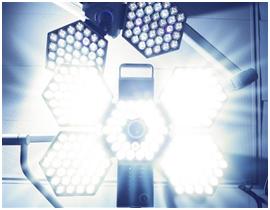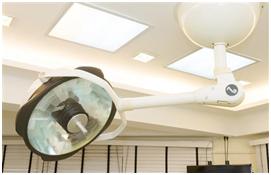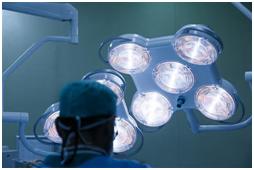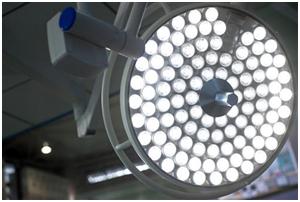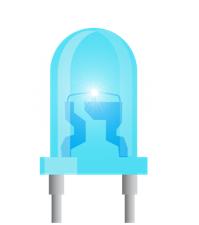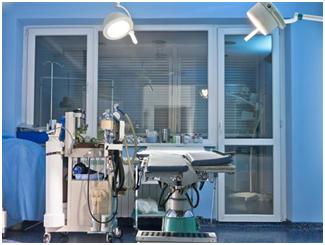|
Efficient Surgical Light Cuts Costs, Improves Patient Care Health care is often a game of numbers, with small, incremental improvements moving the needle forward in improving care for all. Small improvements in efficiency here and there can have a big impact on patient outcomes and costs to health care facilities. Surgical lighting systems represent one aspect of health care where efficiency efforts can have a big impact on patient health, facility expenses, and the environmental impact of the health care industry.
Great advances have been made in recent years to surgical lighting systems, making them easier for doctors and nurses to manipulate, reducing their power consumption and also reducing their heat output. Health care facilities searching for ways to improve patient outcomes and also to control costs should consider the advantages of upgrading their surgical lights.
A History of Surgical Lights
Surgical lights, in short, are medical devices used to provide illumination for medical personnel during surgical procedures. The lighting systems help doctors and nurses see areas where they are performing procedures, improving their accuracy and reducing their risk of inadvertently causing damage.
Up until the late 19th century, the sun provided most of the illumination needed for physicians to perform surgery. Operating rooms used to be constructed to optimize the amount of sunlight available inside. Facilities were constructed facing the southeast with windows installed in the ceiling to allow the maximum amount of sunlight into the building. Procedures were often scheduled based on time of day and whether clouds were obscuring sunlight. Mirrors inside the facilities were used to focus the sunlight, illuminating areas where doctors needed more visibility. Electric lights began being used in the 1880s, allowing surgeons to perform procedures day or night, but early surgical lighting systems were not without problems. Electrical technology was in its infancy, as was electric light, so surgical lighting systems could be unreliable at times. Also, these lighting systems created a lot of heat, resulting in patient and physician discomfort. The technology has progressed greatly since then, and todays modern surgical lighting systems provide superior illumination without the heat that can affect patient and physician comfort and result in negative outcomes. Efficient Surgical Lighting
New regulations and a changing marketplace are pushing health care providers to improve patient outcomes and find ways to reduce costs. Lighting is a big cost for many major health care facilities,
representing more than 10 percent of facilities energy consumption, according to the U.S. Department of Energy. The Energy Department estimates that more than 160,000 surgical lighting systems are in use in hospitals around the U.S. While health care facilities have many lighting needs beyond surgical lights, upgrading these systems can help put a dent in energy consumption related to lighting. Perhaps the most promising lighting technology for improving efficiency is light-emitting diode (LED) lighting technology. While the vast majority of surgical lights currently in use worldwide are incandescent or halogen lights, health care facilities are rapidly adopting LED surgical lights. Most new surgical light sales in Americas top hospitals are for LED lights.
LED lights consist of very small light bulbs that fit easily into an electric circuit. However, unlike traditional light bulbs, LED lights do not have filaments, nor do they get hot. LED light illumination results from the movement of electrons in a semiconductor material. The earliest LED applications were developed in the 1960s.
Perhaps the greatest advantage of LED lights is their reduced energy consumption. LED lights require far less power than traditional lights. The U.S. Energy Department estimates that switching to LED-based surgical lights can save health care facilities up to 47 percent in electrical costs associated with surgical lighting. LED lighting presents a number of advantages over older technologies such as incandescent, fluorescent, and halogen lights for medical lighting applications. LED lights are not just more energy efficient than other lighting types, they also make medical devices for lighting more functional and also improve patient outcomes.
Halogen and incandescent lights were widely adopted because they produced significant amounts of light and rendered colors better. Color rendering is critical to surgical lights because it aids physicians in identifying and differentiating various tissues they encounter in surgical procedures. Todays LED lamps rival halogen lamps in the quality of color rendering they can provide.
In terms of patient and doctor comfort, LED lamps are a superior choice. Halogen lamps can produce excessive amounts of heat, making doctors and nurses performing surgical procedures uncomfortable. They may also cause patient discomfort and contribute to exposed tissue drying during a procedure. LED lights do not produce excess heat, eliminating this problem. Also, LED lights are easier to focus than traditional surgical lighting. LED lights are easier to manipulate than direct light, and they eliminate shadows. Some models allow users to change color temperature, ensuring optimum contrast and thus making it easier for surgeons to identify various tissues during procedures. Another key benefit LEDs hold over traditional lights is their ability to dim. LED surgical lights are easier to dim than traditional lights. Lowering the electrical current is all users need to do to dim an LED light. LED lamps also last much longer than traditional lamps. LED lamps typically have a 10,000 to 50,000 hour useful life, while halogen lamps typically last just 1,000 to 4,000 hours. LED lamps are also usually easier to replace than halogen lamps. LED lamps are more expensive than traditional lamps, but not by significant amounts. When doctors and nurses are able to get clear views of exposed tissues during surgical procedures, their chance of error diminishes. Improving their comfort during these procedures also reduces the risk of mistakes. Facilities that incorporate LED lights into their surgical lighting system wont just save money, they may also save lives. Also, switching to efficient LED lights will reduce health care facilities environmental impact. Because LED lights use less energy and are replaced less often than traditional lights, they consume fewer resources and result in fewer carbon emissions than traditional lights. Considerations for an Upgrade When considering upgrading a health care facilitys surgical lighting systems, health care facility managers have a number of factors they need to weigh before making a decision, including:
Monitoring lighting after a retrofit can also help facilities managers get the full benefit of their investment. By monitoring electrical consumption, replacement and repair costs, and other factors, facilities managers can ensure that problems arent arising that can impair the efficiency of the new surgical lighting system.
Medical Device Depot
carries a large stock of surgical lights and medical devices. With a trained staff of knowledgeable sales professionals, Medical Device Depot can answer any and all questions concerning its stock, allowing clients to make informed decisions concerning their purchases. Medical Device Depot also offers a variety of flexible payment arrangements, and all devices are warrantied.
|

